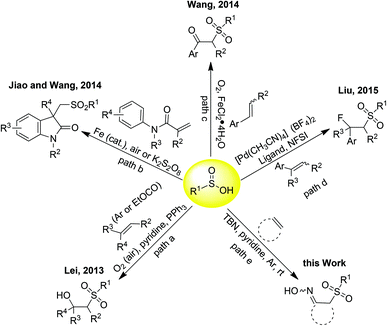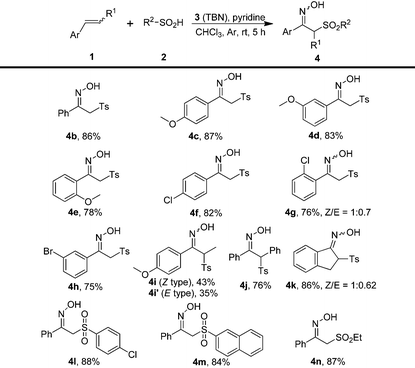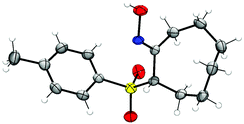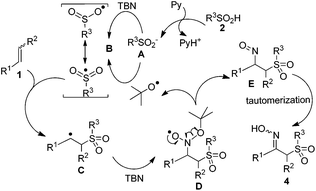tert-Butyl nitrite-mediated vicinal sulfoximation of alkenes with sulfinic acids: a highly efficient approach toward α-sulfonyl ketoximes†
Fei
Chen‡
,
Neng-Neng
Zhou‡
,
Jun-Long
Zhan
,
Bing
Han
* and
Wei
Yu
*
State Key Laboratory of Applied Organic Chemistry, Lanzhou University, Lanzhou, P. R. China. E-mail: hanb@lzu.edu.cn; yuwei@lzu.edu.cn
First published on 26th October 2016
Abstract
A novel vicinal sulfoximation of alkenes was achieved under mild and metal-free conditions by using readily available sulfinic acids as the sulfonating agent and tert-butyl nitrite (TBN) as the radical initiator and the oxime source. Various structurally important α-sulfonyl ketoximes can be prepared from unactivated as well as activated alkenes in high efficiency by utilizing this protocol.
Introduction
Sulfones belong to a basic structural moiety that widely exists in bioactive natural products and pharmaceuticals.1 Thus, efficient incorporation of a sulfonyl group into organic molecules has drawn much attention. In the past few decades, much effort has been made towards this end,2 but the advancement is far from meeting modern synthetic demand. The development of a convenient and efficient approach using simple and easily-obtained sulfonating agents to gain access to sulfone-containing compounds is still worth exploring.Recently, sulfinic acids have been employed as a common and readily available sulfonating reagent to construct sulfone-containing molecules via atom-efficient difunctionalization of alkenes. For instance, in 2013 Lei's group reported an aerobic oxysulfonylation of styrenes and ethyl acrylate using arylsulfinic acids as the sulfonyl source (Scheme 1, path a).3 In 2014, Jiao et al. and Wang et al. independently disclosed the preparation of sulfonated oxindoles via arylsulfonylation of activated alkenes (Scheme 1, path b).4 In the same year, Wang and co-workers reported an iron-catalyzed aerobic oxidative synthesis of β-ketosulfones from styrenes and sulfinic acids (Scheme 1, path c).5 Recently, Liu's group developed a novel Pd-catalyzed fluorosulfonylation of styrenes with arylsulfinic acids and NFSI (Scheme 1, path d).6 Despite these achievements, however, sulfonation of simple and unactivated aliphatic alkenes using sulfinic acids has rarely been documented.7
In continuation of our research on the difunctionalization of unactivated alkenes,8 herein we wish to present a novel and facile radical method for the sulfoximation of various activated and unactivated alkenes. This method uses sulfinic acids as the sulfonating reagent and commercially available tert-butyl nitrite (TBN) as the radical initiator and oximating reagent.9 The oxime motif broadly spreads in pharmaceutically active compounds.10 It is also a versatile functional group in organic synthesis.11 Among the various oximes, those functionalized with sulfonyl groups have special synthetic value as they can be converted to a variety of sulfone-containing compounds.12 Very recently, Li's group reported a new approach towards α-sulfonylethanone oximes by means of copper-catalyzed difunctionalization of styrenes with sodium arylsulfinates and TBN.13 Our strategy described herein not only constitutes the first example of sulfonation of unactivated aliphatic alkenes with sulfinic acids, but also provides a new, mild and efficient method for the synthesis of structurally important α-sulfonyl ketoximes.
Results and discussion
We commenced our study by subjecting styrene (1a) (2 equiv.) to benzenesulfinic acid (2a) (1 equiv.) and TBN (3) (2 equiv.) in CHCl3 under an argon atmosphere at room temperature. After 5 h, the desired product (Z)-1-phenyl-2-(phenylsulfonyl)ethan-1-one oxime (4a) was generated, but only in a low yield of 10% (Table 1, entry 1). Subsequent investigation indicated that a stoichiometric amount of base can dramatically increase the yield of 4a. Among the bases tested, pyridine was more efficient than Et3N and NaOAc (Table 1, entries 2–4); with it 4a can be obtained in 87% yield. Besides CHCl3, several other solvents, such as acetone, CH3CN, DCM, and DMF, were also examined, but they were all inferior to CHCl3 (Table 1, entries 5–8). TBN analogues such as n-BuONO and i-BuONO were also suitable as radical initiators and oxime sources (Table 1, entries 9 and 10), but with them the yield of 4a mildly decreased. Reducing the amount of 1a to 1 equiv. lowered the yield of 4a (Table 1, entry 11), while the yield was increased slightly when 3 equiv. of 1a was used (Table 1, entry 12). Balancing the benefit and the cost, we chose the conditions in entry 3 as the optimized ones.| Entry | Base | Solvent | Yieldb (%) |
|---|---|---|---|
| a Unless otherwise specified, all reactions were carried out by stirring a mixture of 1a (0.6 mmol), 2a (0.3 mmol), 3 (0.6 mmol) and base (0.3 mmol) in 2 mL of solvent under an argon atmosphere (1 atm) at room temperature for 5 h. b Isolated yield based on 2a. c n-BuONO was used instead of TBN. d i-BuONO was used instead of TBN. e 0.3 mmol of 1a was used. f 0.9 mmol of 1a was used. | |||
| 1 | — | CHCl3 | 10 |
| 2 | Et3N | CHCl3 | 79 |
| 3 | Pyridine | CHCl 3 | 87 |
| 4 | NaOAc | CHCl3 | 85 |
| 5 | Pyridine | Acetone | 82 |
| 6 | Pyridine | CH3CN | 75 |
| 7 | Pyridine | CH2Cl2 | 82 |
| 8 | Pyridine | DMF | 83 |
| 9c | Pyridine | CHCl3 | 84 |
| 10d | Pyridine | CHCl3 | 71 |
| 11e | Pyridine | CHCl3 | 61 |
| 12f | Pyridine | CHCl3 | 89 |
Substrate scope
With the optimized conditions in hand, the scope of the reaction was then investigated by applying them to variously substituted styrenes and sulfinic acids. As shown in Table 2, these substituted styrenes reacted smoothly with 4-methylbenzenesulfinic acid to afford the corresponding α-sulfonylethanone oximes 4b–h in excellent yields. trans-Anethole, (E)-1,2-diphenylethene and 1H-indene also participated well in the reaction, delivering 4i–k in 76%–86% yield. The result was equally good when 4-chlorobenzene sulfinic acid and naphthalene-2-sulfinic acid were used (4l and 4m). Notably, ethanesulfinic acid also proved to be a suitable sulfonating reagent under the present reaction conditions; it reacted without difficulty with 1a to yield compound 4n in 87% yield.Having successfully achieved the sulfoximation of styrenes, we next explored the applicability of this new method to aliphatic alkenes (Table 3). To our delight, both linear and cyclic unactivated alkenes reacted well with 4-methylbenzenesulfinic acid, affording the corresponding sulfoximation products 4o–u in good to excellent yields. The structure of 4u was confirmed by single-crystal X-ray diffraction study (Fig. 1). The only exception was cyclohexene. When cyclohexene was used as the substrate, the reaction did not yield the expected sulfoximation product; instead, compound 5v was obtained in a yield of 30%. The structure of 5v was also confirmed by single-crystal X-ray diffraction study (Fig. 2). The yield of 5v can be raised considerably by increasing the amount of 2b, TBN and pyridine. Besides electron-rich alkenes, electron-deficient alkenes such as methyl acrylate and isobornyl acrylate were also suitable substrates for the reaction, as demonstrated by the good yields of 4w and 4x. Unfortunately, when N,N-diallyl-4-methyl benzenesulfonamide (1y) was used as the substrate, the reaction only gave a complex mixture and the desired product 4y was undetected. In case that the alkene substrate incorporates an alkynyl group in its structure, the alkenyl group can be selectively converted with the carbon–carbon triple bond being untouched (4z). When 4-bromobut-1-ene was used as the substrate, on the other hand, 3-(tosylmethyl)-4,5-dihydroisoxazole (4aa) was obtained in 44% yield. Obviously, 4aa was formed through a sulfoximation/intramolecular-SN2 cascade sequence.
| a A mixture of alkenes 1 (0.6 mmol), sulfinic acid 2b (0.3 mmol), TBN (0.6 mmol) and pyridine (0.3 mmol) in CHCl3 (2 mL) was stirred at rt for 5 h. b Isolated yields based on 2b. c Determination of the ratio of Z/E isomers is based on 1H NMR. d Cyclohexene (0.3 mmol), 2b (1.2 mmol), TBN (1.2 mmol), and pyridine (1.2 mmol) were used. |
|---|

|
Follow-up transformation
α-Sulfonyl ketoximes are versatile building blocks in organic synthesis.12 Further transformations of α-sulfonyl ketoximes can provide multiple sulfone-containing compounds that are potentially bioactive molecules or important organic synthetic intermediates.14 As exemplified in Scheme 2, 4a can be easily converted to (Z)-O-acetyl oxime 6 in 93% yield when exposed to acetic anhydride; it readily undergoes deoximation to give 1-phenyl-2-(phenylsulfonyl)ethan-1-one 7 by treatment with Dess–Martin's reagent. Moreover, the BF3·Et2O-induced Beckman rearrangement of 4a provides a highly efficient approach towards N-phenyl-2-(phenyl-sulfonyl)acetamide 8. Last but not least, 4a can be easily switched to 3-phenyl-2-(phenylsulfonyl)-2H-azirine 9. This 2H-azirine skeleton is very useful in the synthesis of pyridines, imidazoles, pyridazines, pyrrolines, and other azacyclic compounds.15Mechanism discussion
Based on our experimental results and previous literature,2g,3,7b a free radical mechanism is proposed to rationalize the TBN-mediated vicinal sulfoximation process. As illustrated in Scheme 3, sulfinic acid 2 is firstly deprotonated by pyridine to give sulfinyl anion A, which is then oxidized to the corresponding radical B by TBN via single electron transfer (SET). Radical B, which can be drawn as the resonance structure of a sulfonyl radical, adds to alkene 1 to give the carbon-centered radical C. C is trapped immediately by TBN, yielding intermediate D. D is then readily transformed into nitroso compound Evia elimination of a tert-butoxyl radical (t-BuO˙). The thus formed t-BuO˙ radical can participate in the oxidation of A as well. Finally, E undergoes tautomerization to yield product 4. This final step is reluctant to take place in the case of cyclohexene, probably due to the destabilizing steric effect and dipole–dipole interaction in the would-be formed α-sulfonyl cyclohexanone oxime product (Fig. 3). Similar phenomena have been observed in other reactions.9b,16a,b As a result, 1-methyl-4-((2-nitrosocyclohexyl)sulfonyl)benzene reacts further with radical B to give 5v.9b,16 | ||
| Fig. 3 Illustration of the destabilizing effect in the would-be formed α-sulfonyl cyclohexanone oxime. | ||
Conclusions
In conclusion, we have developed a facile and efficient metal-free method for the vicinal sulfoximation of alkenes. This method features the use of inexpensive, readily accessible sulfinic acids and tert-butyl nitrite as the reagents, and is advantageous in terms of operational simplicity and atom economy. By using this new method, both activated and unactivated alkenes can be converted to structurally important α-sulfonyl ketoximes. To the best of our knowledge, the present study represents the first example of sulfonation of unactivated aliphatic alkenes with sulfinic acids as the sulfonating reagent, and we hope that the reaction described herein will find applications in the synthesis of bioactive sulfone compounds.Acknowledgements
We thank the National Natural Science Foundation of China (21422205, 21272106 and 21632001), the Program for New Century Excellent Talents in University (NCET-13-0258), the Changjiang Scholars and Innovative Research Team in University (IRT-15R28), the “111” project, and the Fundamental Research Funds for the Central Universities (lzujbky-2016-ct02 and lzujbky-2016-ct08) for financial support.Notes and references
-
(a) R. A. Fromtling, Drugs Future, 1989, 14, 1165 CrossRef
; (b) S. Oida, Y. Tajima, T. Konosu, Y. Nakamura, A. Somada, T. Tanaka, S. Habuki, T. Harasaki, Y. Kamai, T. Fukuoka, S. Ohya and H. Yasuda, Chem. Pharm. Bull., 2000, 48, 694 CrossRef CAS PubMed
; (c) R. Ettari, E. Nizi, M. E. Di Francesco, M.-A. Dude, G. Pradel, R. Vičík, T. Schirmeister, N. Micale, S. Grasso and M. Zappalà, J. Med. Chem., 2008, 51, 988 CrossRef CAS PubMed
.
- For recent selected examples, see:
(a) X. Huang and H. Qian, Synthesis, 2006, 1934 CrossRef
; (b) N. Mantrand and P. Renaud, Tetrahedron, 2008, 64, 11860 CrossRef CAS
; (c) H. H. Li, D. J. Dong, Y. H. Jin and S. K. Tian, J. Org. Chem., 2009, 74, 9501 CrossRef CAS PubMed
; (d) L. R. Reddy, B. Hu, M. Prashad and K. Prasad, Angew. Chem., Int. Ed., 2009, 48, 172 CrossRef CAS PubMed
; (e) Q. Xue, Z. Mao, Y. Shi, H. Mao, Y. Cheng and C. Zhu, Tetrahedron Lett., 2012, 53, 1851 CrossRef CAS
; (f) X. Li, X. Xu, P. Hu, X. Xiao and C. Zhou, J. Org. Chem., 2013, 78, 7343 CrossRef CAS PubMed
; (g) Q. Lu, J. Zhang, G. Zhao, Y. Qi, H. Wang and A. Lei, J. Am. Chem. Soc., 2013, 135, 11481 CrossRef CAS PubMed
; (h) A. K. Singh, R. Chawla and L. D. S. Yadav, Tetrahedron Lett., 2014, 55, 4742 CrossRef CAS
; (i) X. Shi, X. Ren, Z. Ren, J. Li, Y. Wang, S. Yang, J. Gu, Q. Gao and G. Huang, Eur. J. Org. Chem., 2014, 5083 CrossRef CAS
; (j) F. Chen, Q. Meng, S.-Q. Han and B. Han, Org. Lett., 2016, 18, 3330 CrossRef CAS PubMed
.
- Q. Lu, J. Zhang, F. Wei, Y. Qi, H. Wang, Z. Liu and A. Lei, Angew. Chem., Int. Ed., 2013, 52, 7156 CrossRef CAS PubMed
.
-
(a) T. Shen, Y. Yuan, S. Song and N. Jiao, Chem. Commun., 2014, 50, 4115 RSC
; (b) W. Wei, J. Wen, D. Yang, J. Du, J. You and H. Wang, Green Chem., 2014, 16, 2988 RSC
.
- W. Wei, J. Wen, D. Yang, M. Wu, J. You and H. Wang, Org. Biomol. Chem., 2014, 12, 7678 CAS
.
- Z. Yuan, H. Y. Wang, X. Mu, P. Chen, Y. L. Guo and G. Liu, J. Am. Chem. Soc., 2015, 137, 2468 CrossRef CAS PubMed
.
- For recent selected examples on sulfonation of alkenes, see:
(a) T. Taniguchi, A. Idota and H. Ishibashi, Org. Biomol. Chem., 2011, 9, 3151 RSC
; (b) N. Liu, P. Yin, Y. Chen, Y. Deng and L. He, Eur. J. Org. Chem., 2012, 2711 CrossRef CAS
; (c) W. Wei, C. Liu, D. Yang, J. Wen, J. You, Y. Suo and H. Wang, Chem. Commun., 2013, 49, 10239 RSC
; (d) A. Kariya, T. Yamaguchi, T. Nobuta, N. Tada, T. Miura and A. Itoh, RSC Adv., 2014, 4, 13191 RSC
; (e) A. K. Singh, R. Chawla, T. Keshari, V. K. Yadav and L. D. Yadav, Org. Biomol. Chem., 2014, 12, 8550 RSC
; (f) Y. Jiang and T.-P. Loh, Chem. Sci., 2014, 5, 4939 RSC
; (g) R. Chawla, A. K. Singh and L. D. S. Yadav, Eur. J. Org. Chem., 2014, 2032 CrossRef CAS
; (h) N. Taniguchi, J. Org. Chem., 2015, 80, 7797 CrossRef CAS PubMed
; (i) R. Zhu and S. L. Buchwald, J. Am. Chem. Soc., 2015, 137, 8069 CrossRef CAS PubMed
; (j) Z. Z. Chen, S. Liu, W. J. Hao, G. Xu, S. Wu, J. N. Miao, B. Jiang, S. L. Wang, S. J. Tu and G. Li, Chem. Sci., 2015, 6, 6654 RSC
; (k) X. Q. Chu, H. Meng, X. P. Xu and S. J. Ji, Chem. – Eur. J., 2015, 21, 11359 CrossRef CAS PubMed
; (l) K. Sun, Y. Lv, Z. Zhu, Y. Jiang, J. Qi, H. Wu, Z. Zhang, G. Zhang and X. Wang, RSC Adv., 2015, 5, 50701 RSC
; (m) W. Yu, P. Hu, Y. Fan, C. Yu, X. Yan, X. Li and X. Xu, Org. Biomol. Chem., 2015, 13, 3308 RSC
; (n) W. Wei, X. Liu, D. Yang, R. Dong, Y. Cui, F. Yuan and H. Wang, Tetrahedron Lett., 2015, 56, 1808 CrossRef CAS
; (o) S. K. Pagire, S. Paria and O. Reiser, Org. Lett., 2016, 18, 2106 CrossRef CAS PubMed
.
-
(a) B. Han, X.-L. Yang, R. Fang, W. Yu, C. Wang, X.-Y. Duan and S. Liu, Angew. Chem., Int. Ed., 2012, 51, 8816 CrossRef CAS PubMed
; (b) X.-Y. Duan, X.-L. Yang, R. Fang, X.-X. Peng, W. Yu and B. Han, J. Org. Chem., 2013, 78, 10692 CrossRef CAS PubMed
; (c) X.-Y. Duan, N.-N. Zhou, R. Fang, X.-L. Yang, W. Yu and B. Han, Angew. Chem., Int. Ed., 2014, 53, 3158 CrossRef CAS PubMed
; (d) X.-L. Yang, F. Chen, N.-N. Zhou, W. Yu and B. Han, Org. Lett., 2014, 16, 6476 CrossRef CAS PubMed
; (e) X.-Y. Duan, P.-P. Jia, M. Zhang and B. Han, Org. Lett., 2015, 17, 6022 CrossRef CAS PubMed
; (f) X.-L. Yang, Y. Long, F. Chen and B. Han, Org. Chem. Front., 2016, 3, 184 RSC
; (g) F. Chen, X.-L. Yang, Z.-W. Wu and B. Han, J. Org. Chem., 2016, 81, 3042 CrossRef CAS PubMed
; (h) X.-L. Yang, X.-X. Peng, F. Chen and B. Han, Org. Lett., 2016, 18, 2070 CrossRef CAS PubMed
; (i) R.-H. Liu, D. Wei, B. Han and W. Yu, ACS Catal., 2016, 6, 6526 Search PubMed
.
- For nitrosation (oximation) of alkenes using TBN, see:
(a) K. Sugamoto, Y. Hamasuna, Y. Matsushita and T. Matsui, Synlett, 1998, 1270 CrossRef CAS
; (b) T. Hirabayashi, S. Sakaguchi and Y. Ishii, Angew. Chem., Int. Ed., 2004, 43, 1120 CrossRef CAS PubMed
; (c) M. Hashimoto, S. Sakaguchi and Y. Ishii, Chem. – Asian J., 2006, 1, 712 CrossRef CAS PubMed
; (d) S. Prateeptongkum, I. Jovel, R. Jackstell, N. Vogl, C. Weckbecker and M. Beller, Chem. Commun., 2009, 1990 RSC
; (e) R. Ray, A. D. Chowdhury, D. Maiti and G. K. Lahiri, Dalton Trans., 2014, 43, 38 RSC
; (f) X.-X. Peng, Y.-J. Deng, X.-L. Yang, L. Zhang, W. Yu and B. Han, Org. Lett., 2014, 16, 4650 CrossRef CAS PubMed
. For nitration of alkenes using TBN, see: (g) T. Taniguchi, A. Yajima and H. Ishibashi, Adv. Synth. Catal., 2011, 353, 2643 CrossRef CAS
; (h) T. Taniguchi, Y. Sugiura, T. Hatta, A. Yajima and H. Ishibashi, Chem. Commun., 2013, 49, 2198 RSC
; (i) S. Maity, T. Naveen, U. Sharma and D. Maiti, Org. Lett., 2013, 15, 3384 CrossRef CAS PubMed
; (j) U. Dutta, S. Maity, R. Kancherla and D. Maiti, Org. Lett., 2014, 16, 6302 CrossRef CAS PubMed
; (k) H. Yan, G. Rong, D. Liu, Y. Zheng, J. Chen and J. Mao, Org. Lett., 2014, 16, 6306 CrossRef CAS PubMed
; (l) G. B. Deng, J. L. Zhang, Y. Y. Liu, B. Liu, X. H. Yang and J. H. Li, Chem. Commun., 2015, 51, 1886 RSC
. For TBN-mediated N-incorporation reactions, see: (m) F. Chen, X. Huang, X. Li, T. Shen, M. Zou and N. Jiao, Angew. Chem., Int. Ed., 2014, 53, 10495 CrossRef CAS PubMed
; (n) Y. Liu, J. L. Zhang, R. J. Song, P. C. Qian and J. H. Li, Angew. Chem., Int. Ed., 2014, 53, 9017 CrossRef CAS PubMed
.
-
(a) J. Kassa, K. Kuca, L. Bartosova and G. Kunesova, Curr. Org. Chem., 2007, 11, 267 CrossRef CAS
; (b) J. Kassa and J. Karasova, Toxicology, 2007, 229, 136 CrossRef CAS PubMed
; (c) J. Kassa, J. Karasova, K. Musilek and K. Kuca, Toxicology, 2008, 243, 311 CrossRef CAS PubMed
.
- K. Narasaka and M. Kitamura, Eur. J. Org. Chem., 2005, 4505 CrossRef CAS
.
- V. Padmavathi, B. C. O. Reddy, P. Thriveni and A. V. Nagendra Mohan, Synth. Commun., 2007, 37, 3127 CrossRef CAS
.
- J. Yang, Y.-Y. Liu, R.-J. Song, Z.-H. Peng and J.-H. Li, Adv. Synth. Catal., 2016, 358, 2286 CrossRef CAS
.
-
(a) J. L. Marco, I. Fernández, N. Khiar, P. Fernández and A. Romero, J. Org. Chem., 1995, 60, 6678 CrossRef CAS
; (b) M. Ihara, S. Suzuki, T. Taniguchi, Y. Tokunaga and K. Fukumoto, Tetrahedron, 1995, 51, 9873 CrossRef CAS
; (c) J. D. White, P. R. Blakemore, S. Milicevic, S. C. Choudhry, J. Cupano and L. Serico, Org. Lett., 2002, 4, 1803 CrossRef CAS PubMed
; (d) C. E. Wheelock, M. E. Colvin, I. Uemura, M. M. Olmstead, J. R. Sanborn, Y. Nakagawa, A. D. Jones and B. D. Hammock, J. Med. Chem., 2002, 45, 5576 CrossRef CAS PubMed
.
-
(a) S. Auricchio, S. Grassi, L. Malpezzi, A. S. Sartori and A. M. Truscello, Eur. J. Org. Chem., 2001, 1183 CrossRef CAS
; (b) A. Prechter, G. Henrion, P. Faudot dit Bel and F. Gagosz, Angew. Chem., Int. Ed., 2014, 53, 4959 CrossRef CAS PubMed
.
-
(a) M. Y. Balakirev and V. V. Khramtsov, J. Org. Chem., 1996, 61, 7263 CrossRef CAS PubMed
; (b) B. Patel, J. Carlisle, S. E. Bottle, G. R. Hanson, B. M. Kariuki, L. Male, J. C. McMurtrie, N. Spencer and R. S. Grainger, Org. Biomol. Chem., 2011, 9, 2336 RSC
.
Footnotes |
| † Electronic supplementary information (ESI) available. CCDC 1481286 (4u) and 1481285 (5v). For ESI and crystallographic data in CIF or other electronic format see DOI: 10.1039/c6qo00535g |
| ‡ These authors contributed equally to this work. |
| This journal is © the Partner Organisations 2017 |







